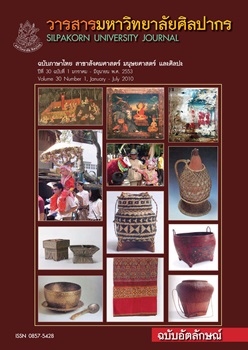การสร้าง “พระราชชายาเจ้าดารารัศมี” ให้เป็นบุคคลสำคัญในประวัติศาสตร์ทศวรรษ 2500 ปัจจุบัน The Construction of “Phrarajjaya Chao Dararasmi” As a Historical Figure from the 1900s to the Present
Main Article Content
Abstract
บทคัดย่อ
บทความนี้มีวัตถุประสงค์เพื่อศึกษาความเปลี่ยนแปลงในการสร้าง “พระราชชายาเจ้าดารารัศมี” ให้เป็น “บุคคลสำคัญในประวัติศาสตร์” ตั้งแต่ทศวรรษ 2500 จนถึงปัจจุบัน ซึ่งมีความสัมพันธ์อย่างลึกซึ้งกับการจัดความสัมพันธ์เชิงอำนาจ ระหว่าง “ท้องถิ่น” (ล้านนา) กับ “ชาติไทย” และมีผลต่อพระสถานภาพและพระราชอำนาจของพระมหากษัตริย์แห่งชาติไทยตลอดจนต่อสถานภาพและพื้นที่ทางสังคมของเจ้านายฝ่ายเหนือด้วย
การที่บุคคลหนึ่งถูกสร้างให้เป็น “บุคคลสำคัญในประวัติศาสตร์” นั้น ย่อมมีความหมายทางการเมืองแฝงอยู่ด้วยเสมอ เพราะว่า “ความทรงจำ” ที่ประวัติศาสตร์สร้างขึ้นมา มีผลต่อการจัดความสัมพันธ์เชิงอำนาจในสังคมการเมืองที่เป็นเจ้าของ “ความทรงจำ” นั้นๆ การศึกษาเรื่อง “การสร้าง ‘พระราชชายาเจ้าดารารัศมี’ ให้เป็นบุคคลสำคัญในประวัติศาสตร์” จึงมิใช่การค้นหาความจริงเกี่ยวกับชีวประวัติของบุคคล หากแต่เป็นการศึกษาถึงการสถาปนามโนทัศน์ทางการเมืองที่เกี่ยวโยงกับการจัดความสัมพันธ์เชิงอำนาจระหว่าง “ชาติไทย” กับ “ท้องถิ่น” และความสัมพันธ์เชิงอำนาจภายใน “ท้องถิ่น” และภายใน “ชาติไทย” ซึ่งปรากฏอย่างชัดเจนในการสร้างความทรงจำเกี่ยวกับพระราชชายาเจ้าดารารัศมีโดยหลายฝ่ายนับตั้งแต่ทศวรรษ 2500 เป็นต้นมา โดยแต่ละฝ่ายได้สร้าง“โครงเรื่อง” และเสนอเรื่องราวเกี่ยวกับพระราชชายาเจ้าดารารัศมีในฐานะบุคคลสำคัญในประวัติศาสตร์ท้องถิ่น และ/หรือประวัติศาสตร์ชาติไทย ภายใต้โครงเรื่องหลักและโครงเรื่องย่อยที่แตกต่างหลากหลาย และนำเสนอในรูปแบบต่างๆ เช่น งานเขียนทางประวัติศาสตร์ งานเขียนเชิงสารคดี อนุสาวรีย์ พิพิธภัณฑ์ พิธีกรรม แสตมป์ ฯลฯ ทำให้ “โครงเรื่อง” มีความลื่นไหล ผันแปรไปตามบริบททางสังคมของผู้สร้าง “โครงเรื่อง” เหล่านั้น อย่างไรก็ตาม มีโครงเรื่องบางโครงเรื่องที่ได้รับการสืบทอดอย่างเข้มข้น จนสร้างความทรงจำกระแสหลักเกี่ยวกับพระราชชายาเจ้าดารารัศมีขึ้นมา นั่นคือโครงเรื่องที่มาจากอุดมการณ์ “ราชาชาตินิยม” แบบที่เห็นว่าท้องถิ่นเป็นส่วนหนึ่งที่มีคุณค่าและน่าภาคภูมิใจของชาติไทย โดยที่ความรักและความผูกพันระหว่างพระราชชายาเจ้าดารารัศมีกับพระบาทสมเด็จพระจุลจอมเกล้าเจ้าอยู่หัวได้กลายเป็น “สายใยรักสองแผ่นดิน” ที่ช่วยประสานล้านนาเข้ากับชาติไทยอย่างมั่นคงตลอดมา
ในขณะที่ความทรงจำกระแสหลักดังกล่าวข้างต้นได้รับการผลิตซ้ำจนมีอิทธิพลอย่างมากในสังคม และยังผันแปรไปเป็น “ลัทธิพระราชชายาฯ” ด้วยนั้น เรื่องราวเกี่ยวกับพระราชชายาเจ้าดารารัศมีที่มีโครงเรื่องแบบ “ท้องถิ่นนิยมที่ต่อต้านชาตินิยม” กลับไม่ได้รับการสืบทอดแต่อย่างใด ขณะเดียวกันความขัดแย้งในยุคปฏิรูปประเทศการดูถูกเหยียดหยามทางชาติพันธุ์ และความขมขื่นต่างๆ ล้วนได้รับการให้ความหมายหรือการอธิบายใหม่เพื่อให้สังคมได้รับรู้และยอมรับว่า “ท้องถิ่น” เต็มใจรวมเข้าเป็นส่วนหนึ่งของ “ชาติไทย” และได้รับผลดีอย่างมากจากการมี “สายใยรักสองแผ่นดิน” ดังนั้น “ท้องถิ่น” จึงควรจงรักภักดีต่อพระมหากษัตริย์แห่ง “ชาติไทย” อย่างสูงสุดและร่วมสร้างสรรค์ความเจริญแก่ท้องถิ่นเพื่อความเจริญรุ่งเรืองของ “ชาติไทย” โดยรวมตลอดไป
การทำความเข้าใจ “การสร้าง ‘พระราชชายาเจ้าดารารัศมีให้เป็นบุคคลสำคัญในประวัติศาสตร์ ทศวรรษ 2500 – ปัจจุบัน” จึงช่วยให้เข้าใจ “รัฐไทย” “ชาติไทย” และ “ความเป็นไทย” อย่างลึกซึ้งและซับซ้อนขึ้น รวมทั้งทำให้เข้าใจงานเขียนประวัติศาสตร์ชาติและประวัติศาสตร์ท้องถิ่นเรื่องอื่นๆ ซึ่งให้พื้นที่ทางสังคมหรือให้สิทธิและอำนาจแก่คนกลุ่มต่างๆ ในท้องถิ่นและในชาติแตกต่างกันออกไป นอกจากนี้ยังช่วยเสริมสร้างวิจารณญาณให้แก่คนไทยและช่วยให้คนไทยเป็นอิสระจากกระบวนทัศน์ครอบงำอีกโสดหนึ่งด้วย
คำสำคัญ : 1. เจ้าดารารัศมี พระราชชายาในพระบาทสมเด็จพระจุลจอมเกล้าเจ้าอยู่หัว.
Abstract
This article aims to study the dynamics of “The Construction of ‘Phrarajjaya Chao Dararasmi’ as a Historical Figure from the 1900s to the Present.” This is closely related to the power relations between the “local” (Lanna) and the “Thai nation,” which affected the status as well as authority of the King of Thailand and the social rank of the northern noble families.
Construction of a historical figure always comes hand-in-hand with a political meaning hidden in its agenda because “collective memory” derived from historical knowledge is the basic cause of power relations in political society. Hence the study about the construction of ‘Phrarajjaya Chao Dararasmi’ as a historical figure is not a dry search for truth or facts of an individual biography. It is rather research about the foundation of political perception related to power relations between the “Thai nation” and the “local”, as well as the actual power relationships among the locals and the nation itself. Those are dramatically afforded in the diversity of the Construction of Phrarajjaya Chao Dararasmi as a heroine in local history and/or Thai history in different mainplots and subplots; these can be seen in the emergence of historical writings, documentaries, statues, rituals, stamp collections and so on. A variety of representatives and mediums make “the plot” liquidized according to the social contexts to which the writers belong. However, there are some plots which abided so unceasingly that they become the main stream of remembrance about Phrarajjaya Chao Dararasmi. This study asserts that these plots are based on a certain concept of “royal nationalism.” In this concept, it is believed that the locals are a contented part of Thailand as a whole. The plots reveal the love and relationship between Phrarajjaya Chao Dararasmi and King Chulalongkorn, the “Love beyond two boundaries” which efficiently helps to reconcile Lanna into the integrated part of the Thai nation.
While the main-stream impressions are repeatedly reproduced in society, and even developed into “Phrarajjayaism,” the ‘plot’ containing ‘antipatriotic localization’ is neglected. It seems to have been conflicted in the reformation era. The discrimination and other bitterness in local history are left behind in the backstage of the romantic drama called “Love beyond two boundaries”; this romantic drama functioned to create the perception in society that the “local” was glad to degenerate herself to become part of the nation-state and acquired gratifying priority from the “Love beyond two boundaries” itself. Accordingly, the idea that the “ local” ought to be immensely loyal towards the King of Siam then creates growth to the “local”, as obligation, to make the Thai nation ever more glorious. Understanding “The Construction of ‘Phrarajjaya Chao Dararasmi’ as a Historical Figure from the 1900s to the Present” will help one to consider the Thai nation, the Thai state, and “being Thai” in a more complicated way. Moreover, how other national history and local history provide the social space, right and authority to various groups of people in local and state society will be also engaged. In another stage of the comprehension, this thesis could engender insight for the Thais and free people from the draconian dominance paradigm of the past.
Keyword: 1. Chao Dararasmi, Phrarajjaya, consort of Chulalongkorn, King of Siam.


